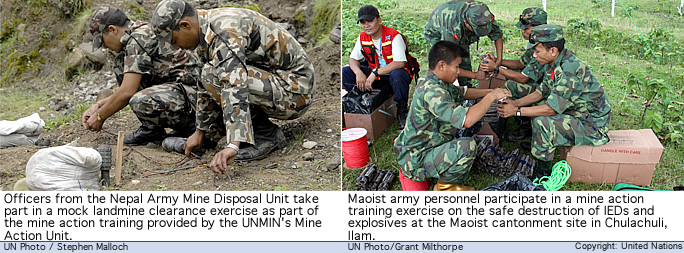|
Reports
on Nepal's Civil War: Landmines |
|
|
|
Reports
on Landmines in Nepal |
|

|
Demining
under way but threat of casualties persists |
 |
KATHMANDU,
3 June 2008 (IRIN)
 |
| The
demining process is making steady progress, according to the UN Mission
in Nepal (UNMIN), which has been involved in the clearance and destruction
of landmines and improvised explosive devices (IEDs) since November 2007,
supported by a team of international specialists from ArmorGroup. |
|
By
May 2008, UNMIN's Mine Action unit had destroyed more than 14,500 IEDs
stored in seven main cantonments and two satellite camps of the former
Maoist rebels. The UN has been supervising the management of arms and armies
since the end of the decade-long armed conflict and peace accord signing
in November 2006. Almost all the IEDs in the Maoist sites have been destroyed,
according to UNMIN.
Officials
told IRIN the mission had also helped the Nepal Army to clear four out
of 53 anti-personnel landmine sites in and around army barracks and camps
? all of which are estimated to hold more than 14,000 landmines laid by
the army to thwart off possible Maoist attacks.
Although
the number of casualties from IEDs and anti-personnel landmines has fallen
compared with the last several years because of demining and mine-risk
education programmes, there is still a lot of potential danger, according
to a national NGO, Ban Landmines Campaign Nepal (NCBL).
Between
1998 and 2007, there were 4,809 victims of IEDs and landmines, more than
half of whom were children, according to NCBL. Between January to May 2008,
the number of casualties was 24, of whom 17 were children.
"Statistically,
children are becoming more vulnerable. Seventy-five percent of the casualties
involved in victim-activated explosions were children this year compared
with 50-57 percent in the past," UN's mine action consultant Hugues Laurenge
told IRIN.
He
said there was a need for mine-risk education to improve awareness about
the location of abandoned, unexploded or stored IEDs.
There
is also a danger of IEDs in the Terai region of southern Nepal, where armed
groups have been using IEDs, resulting in civilian casualties, according
to a report, Local View on Mine Action and Ottawa Treaty by NCBL.

 |
Source:
IRIN, June 2008
Copyright
© UN Office for the Coordination of Humanitarian Affairs 2008
[
This report does not necessarily reflect the views of the United Nations]
Integrated
Regional Information Networks (IRIN), part of the UN Office for the Coordination
of Humanitarian Affairs (OCHA). |
|



![]()

